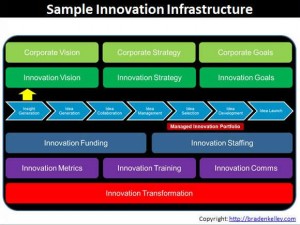
One of the most important efforts you’ll want to make as part of Five Ways to Make Your Innovation Culture Smell Better (free white paper download) is to create a common language of innovation.
Unfortunately, there is no universally accepted definition of the word innovation, and there have even been multiple articles written by the Doblin Group, Geoffrey Moore and others about how many different types of innovation there are and how you must choose which types of innovation to focus on. When it comes to innovation, individuals speak about it differently and there are lots of misunderstandings.
A common language of innovation is the foundation of any sustainable innovation effort and is realized by putting these five building blocks in place:
1. Define what Innovation will mean in your organization
Innovation means so many different things to so many different people that every organization should consciously sit down and define what innovation means for them (and what it does not). Setting the baseline for people in your organization for what innovation is, and what it isn’t, is the first and most important building block in a sustainable innovation foundation.
My definition is:
“Innovation transforms the useful seeds of invention into widely adopted solutions valued above every existing alternative.”
This definition highlights a difference between useful vs. valuable and invention vs. innovation and emphasizes that something must be widely adopted to be an innovation (at the expense of something else).
Next you’ll want to consider how company vision, strategy, goals and infrastructure impact innovation within your organization.
2. Create an Innovation Vision
Employees need to know why innovation is important and what leadership’s vision is for the innovation direction of the organization so they apply their efforts in a manner consistent with the vision.
John Kotter, as part of his change principals, highlighted six key characteristics of an effective vision:
- Imaginable: They convey a clear picture of what the future will look like.
- Desirable: They appeal to the long-term interest of those who have a stake in the enterprise.
- Feasible: They contain realistic and attainable goals.
- Focused: They are clear enough to provide guidance in decision making.
- Flexible: They allow individual initiative and alternative responses in light of changing conditions.
- Communicable: They are easy to communicate and can be explained quickly.
Your innovation vision should ask and answer:
- WHERE are we focusing our innovation efforts?
- WHY are we pursuing innovation?
3. Craft an Innovation Strategy
When it comes to setting an innovation strategy, organizations should ask and answer the following questions in setting their innovation strategy:
- WHAT are we doing to try and realize our vision?
- WHO is expected to participate?
Chris Thoen, former head of the Connect+Develop program at P&G had this to say about P&G’s innovation strategy:
“P&G has incredibly talented employees – employees who are proud of the work they do. Moving from “only invented at P&G” to “proudly found elsewhere” required a change in mindset. It was important that employees realized that Connect + Develop was not another name for downsizing and outsourcing jobs but instead, a strategy to ensure sustained business growth for the Company.”
Determine who and what are you going to focus on as part of your innovation strategy and its goals.
4. Set Your Goals for Your Innovation Efforts
When it comes to goals, the S.M.A.R.T. framework states that goals must be:
- Specific
- Measurable
- Achievable
- Realistic
- Time-bound
When created thoughtfully and consistently with S.M.A.R.T. goal principles, your innovation goals should tell everyone how you are trying to execute on your innovation strategy and vision. One of P&G’s innovation goals was to source 50% of the company’s innovation from outside. This was measured by looking at the source of new product launches and other variables.
5. Build an Innovation Infrastructure That Demonstrates Your Commitment to Innovation
The final building block is achieved by building a framework and a methodology for innovation that your organization can embrace, and by putting the financial and human resources in place to help innovation projects emerge, get funded, and be brought to market successfully. Below you’ll find a sample innovation infrastructure highlighting some of the areas you’ll want to develop and a snapshot of innovation staffing at Whirlpool that shows how deeply their innovation focus is embedded throughout the organization:


Conclusion
If you establish an innovation definition, vision, strategy, goals, and infrastructure you will be well on your way to creating a common language of innovation, which will help to drive alignment, and ultimately, success!
Next Steps:
- Watch my FREE Pipeline 2014 keynote session (ON DEMAND) exploring five ways to improve your innovation culture.
- Download the FREE WHITE PAPER – Five Ways to Make Your Innovation Culture Smell Better – from the Planview web site.
Image credit: sciencenews.org
References:
1. Stoking Your Innovation Bonfire by Braden Kelley
2. Leading Change by John P. Kotter
3. https://www.doblin.com/tentypes/
4. https://www.dealingwithdarwin.com/resources/pptDownloads.php

![]() Sign up here to get Human-Centered Change & Innovation Weekly delivered to your inbox every week.
Sign up here to get Human-Centered Change & Innovation Weekly delivered to your inbox every week.
Pingback: Let’s Chat About the Language of Innovation | Human-Centered Change and Innovation